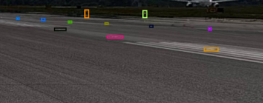FOD AI Beta Program: Five Weeks of Failure, Progress, and Partnership
- Brian Freed
- Aug 27
- 4 min read

Five weeks ago, Illuminex AI launched our FOD AI Beta Program with bold ambitions. Our mission was clear: validate the functionality of our AI-powered Foreign Object Debris (FOD) detection platform in real-world airport environments while stress-testing it in the most chaotic conditions possible. As outlined in our kickoff blog, we set out to push the boundaries of innovation in airport safety. Today, we’re thrilled to share an update on our progress, reflecting on the failures that have fueled our growth and the partnerships that are shaping the future of FOD detection.
Embracing Chaos to Build a Better Product
To ensure our platform could withstand the complexities of real-world operations, we selected four diverse airports for the beta program. From Morristown Municipal Airport (MMU), a small general aviation hub, to one of the largest commercial airports in the United States, our beta sites represent a cross-section of environments. Savannah/Hilton Head International Airport (SAV) introduced coastal humidity, while a large Texas airport brought relentless summer heat and blazing sunshine. Our goal was to maximize diversity and uncover every possible weakness in the system.
By that measure, we succeeded spectacularly. The real world threw us a gauntlet of challenges. Radio frequency interference disrupted GPS signals, forcing us to rethink our hardware choices. The intense Texas sun overexposed camera sensors, revealing the need for advanced low-level controls to adapt to diverse lighting conditions. Coastal humidity fogged protective lenses, prompting a redesign of our sensor housing. At one site, an in-vehicle navigation system mistook our GPS signals for its own, displaying them as red dots on the dashboard map. These issues were just the tip of the iceberg for our third-party sensor integrations.
Our AI models and user interface faced their own hurdles. Differences in airfield lighting and pavement markings between our development airport and beta sites triggered a wave of false positive FOD detections. Each challenge was a lesson, and we leaned into them with enthusiasm (albeit frequently weary enthusiasm), rolling up our sleeves to refine the product.
Turning Failure into Progress
At Illuminex AI, we don’t shy away from failure; we embrace it as a catalyst for improvement. Over the past five weeks, our team has tackled each issue head-on. We tested and integrated new GPS receivers with enhanced RF filtering to stabilize positioning data. We fixed bugs in our platform and, in some cases, collaborated with third-party vendors to address issues in their systems. To reduce false positives, we expanded our training data to include newly identified objects and developed advanced filtering methodologies.
With each iteration, our FOD detection platform has grown more robust, accurate, and ready for the demands of the market. This progress is a testament to our philosophy: great products aren’t born from genius ideas alone but from relentless effort and real-world feedback.
Our beta customers, early adopters who believe in the transformative potential of AI-driven augmentation for airfield inspection, along with Fortbrand Services LLC, our reseller partner, have been instrumental in this journey. Their willingness to endure early challenges and provide detailed feedback has been the linchpin of our success. Together, we’re not just building a product; we’re redefining how airports inspect and maintain critical infrastructure.
Celebrating Milestones and Looking Ahead
As we close out the first quarter of our beta program, we’re proud of both the failures that have taught us and the progress that has propelled us forward. We’re in the final stages of training and evaluating our next deployed model, which promises to significantly reduce false positives caused by airfield lighting. Additionally, we’re introducing a moving map interface based on partner feedback. This new feature will provide clearer, less distracting insights compared to the traditional video stream with red bounding boxes around detected FOD.
Our airport partners have been with us every step of the way, offering their expertise and patience as we refine the platform. Their collaboration is the heartbeat of this project, and we’re deeply grateful for their commitment to driving innovation in airport safety.
The Path Forward
The past five weeks have been a whirlwind of challenges, debugging sessions, and breakthroughs. Each step, both setbacks and wins, has brought us closer to our vision of transforming airfield inspections. As we move into the next phase of the beta program, we’re energized by the road ahead and the opportunity to tackle new challenges with our partners by our side.
This work is only the beginning. Our FOD AI Beta Program lays the foundation for a broader suite of AI-driven inspection tools. This winter we’ll begin beta testing for SnowPro AI, our drift height profiling solution. Looking further ahead, we’re preparing beta programs for Lighting and Surface Inspection solutions in 2026.
We invite you to follow our journey, learn from our progress, and witness how we are transforming airport safety. And if you’re ready to play a role in shaping the future of airfield inspection, we’d love to hear from you. Reach out to explore partnership opportunities or to express interest in joining one of our upcoming beta programs.
Together, we are redefining inspection.

























